Are you tired of acne scar treatments that don’t work?
I know I am.
Unfortunately, the Internet is full of misleading advice on acne scars.
Recommendations include everything from baking soda to lemon juice to tea tree oil, despite the lack of clinical evidence and potential harm to your skin.
So what can you do?
For starters, you need to understand the different types of acne scars because each one has its own treatment options. There is no “all-in-one” scar solution.
In this post, I’ll show you the top 5 acne scar treatments that are clinically proven to work and 5 things to avoid (hint: I already mentioned 3 of them).
Types of Acne Scars
In short, acne scars are caused by chronic inflammation during acne.
The most severe types of acne (cystic & nodular) tend to leave behind the worst acne scars. That’s why it’s important to get active acne under control to prevent future scarring.
Now, let’s look at the different types of acne scars.
Atrophic Scars

Also known as indented or pitted scars, atrophic scars are caused by a loss of collagen following chronic inflammatory acne. Collagen is an important material that supports the overall structure of your skin.
These include:
- Ice Pick Scars: small narrow holes in the skin like “ice pick” punctures
- Boxcar Scars: indentations with borders (like a fingernail pressed into the skin)
- Rolling Scars: depressions with no borders (like waves or ripples)
- Tethered Scars: fibrous bands underneath the scar that pull down on it
Raised Scars

Other times, acne scars can end up elevated if your body produces too much collagen. Raised scars are thick, lumpy, and may feel itchy.
These include:
- Hypertrophic Scars: raised, red, bumpy, may recede on its own
- Keloids: raised, red to purple, itchy, tends to grow larger over time
Hyperpigmentation
Dark spots are another side effect of acne and often goes away on its own. Also known as post-inflammatory hyperpigmentation (PIH), dark spots are caused by excess melanin.
- Hyperpigmentation: dark spots from excess melanin

Best Treatment for Ice Pick Scars
TCA CROSS
For ice pick scars (especially deep ones), the best treatment is TCA CROSS. This stands for Trichloroacetic Acid (TCA) Chemical Reconstruction of Skin Scars (CROSS).
About the Procedure
TCA CROSS is a simple procedure done by a dermatologist. He or she applies a high concentration of TCA, typically 70-100%, with a toothpick to the base of your ice pick scars.
The chemical solution burns away scar tissue and triggers collagen growth to rebuild healthy skin. This process eventually fills in ice pick scars and reduces scar appearance.
Clinical Evidence
Research on TCA CROSS suggests an average of 25% scar improvement after one session. Most people need around 3 to 6 sessions every 2-8 weeks.
The Bottom-Line
TCA CROSS is a clinically proven treatment for ice pick scars.
Best Treatments for Boxcar & Rolling Scars
Microneedling
For pitted scars like boxcar and rolling scars, microneedling is a safe and effective option that can be done at home or by a professional.
The idea is to stimulate collagen remodeling by creating micro wounds in your skin.
The tool of choice can be a derma roller with dozens of tiny needles, a derma stamp (for areas that are harder to reach), or a professional derma pen (electric powered).
About the Procedure
The microneedling tool is used to “punch” tiny holes into your skin and encourage collagen deposition. After a few sessions, you should notice smoother skin with fewer scar marks.
If you prefer a DIY route, you can get derma rollers for less than $20 online. However, proper technique and consistency are required to achieve scar improvements.
Professional microneedling is also available at most dermatologist offices. A minimum of 4-6 sessions is recommended for scar treatment.
Clinical Evidence
Between 2011 and 2016, eleven papers evaluated the effectiveness of microneedling. Most concluded that it was effective on its own or in combination with other scar treatments like chemical peels and subcision.
In particular, one study in 2014 of 30 patients found microneedling produced significant results with an average improvement of 50-75% on a scar assessment scale.
The Bottom-Line
Microneedling is an affordable and effective technique for boxcar & rolling scars.
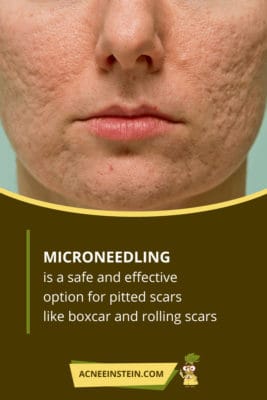
Subcision
Subcision is an excellent scar treatment that is best suited for tethered scars.
That means there are fibrous bands between the underlying skin tissue and the base of the scar. These fibrotic tethers pull down on the scar and create the impression of “dips”.
About the Procedure
Your dermatologist will inject a local anesthetic before the procedure. He or she then inserts a special needle beneath your skin to manually break the fibrotic strands. This releases the tension holding the scar down and allows the skin to heal normally.
Side effects of subcision include hypertrophic scarring, mild bleeding, and pain.
Clinical Evidence
In a 2005 study of 40 patients, subcision led to approximately 50% improvement in scar appearance according to both patients and investigators.
The Bottom-Line
Subcision is the preferred method of removing tethered acne scars.
Best Treatments for Raised Scars
Silicone Gels and Sheets
Silicone is recommended by the International Advisory Panel on Scar Management as the first-line of treatment for hypertrophic scars and keloids.
I’ve personally used both silicone gels and sheets on my own scars with great success. They are easy to apply, dry quickly, and effective at minimizing scars.
About the Procedure
No doctor visits required. All you need to do is apply the silicone gel or sheet onto your scar at least twice a day. For silicone sheets, I like to alternate between 2 sheets (day/night) to ensure continuous scar coverage.
Clinical Evidence
Researchers believe that silicone works by hydrating and protecting the scar tissue. Skin dehydration can trigger excess collagen production which leads to raised scars.
In a 2017 review, researchers noted that silicone gels and sheets were effective at preventing scars and reducing scar thickness.
The Bottom-Line
Silicone gels and sheets are both affordable and effective for raised scars.
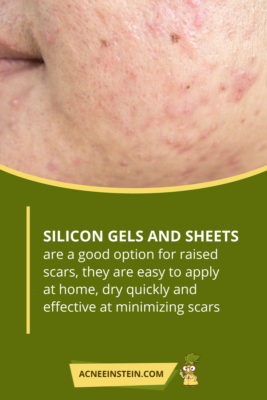
Corticosteroid Injections
For more severe scars, you may want to consider corticosteroid injections. This procedure is recommended by the International Advisory Panel on Scar Management for keloids and major hypertrophic scars.
I’ve had great results with corticosteroid injections for flattening the keloids on my chest and jawline. Generally, 2 to 3 injections are sufficient but more may be required.
About the Procedure
Your dermatologist will prepare a solution of triamcinolone (the corticosteroid). After disinfecting your scar, he or she will administer the injection. The process is quick but can be painful depending on the area (chest injections are the most painful).
There is no downtime required. Any bleeding or swelling is temporary.
Clinical Evidence
Researchers believe corticosteroids have strong anti-inflammatory properties that reduce overactive collagen production. This may explain why it flattens raised scars so well.
While clinical studies are relatively limited, corticosteroid injections have been used for decades by dermatologists for both hypertrophic scars and keloids.
The Bottom-Line
Corticosteroid injections are an effective option for severe raised scars.
5 Things to Avoid for Acne Scars
When it comes to acne scars, the Internet is full of myths and short on facts.
As a rule of thumb for any scar treatment, you should ask yourself,
“Does this treatment influence collagen in some way?”
For atrophic scars, you want to stimulate collagen production to fill in scar cavities. For raised scars, you want to reduce collagen levels to flatten scar tissue.
Here are 5 popular remedies that do not have sufficient clinical evidence for acne scars.
Baking Soda
Despite the miraculous claims, baking soda belongs in the kitchen, not on your face!
Your skin has something called an “acid mantle” that protects you from bacteria and other pathogens. The skin’s pH is weakly acidic at around 5.7 (pH of 7 is neutral).
Since baking soda is basic (pH of 8.3), it raises the overall pH of your skin. This neutralizes the acid mantle and makes it easier for bacteria and fungi to survive, which can lead to acne breakouts and fungal infections.
For some people, baking soda also triggers skin reactions such as rashes, redness, and burning.
In short, there’s no reason to use baking soda on your skin, let alone for acne scars.
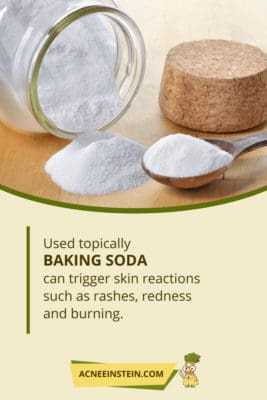
Lemon Juice
Lemon juice is another popular recommendation for acne scars.
Advocates argue that lemon improves scars using alpha hydroxy acids like citric acid and skin brighteners like ascorbic acid (vitamin C) and niacin.
However, the concentration of these ingredients tends to be very low in lemons (5% citric acid, 0.04% ascorbic acid, and 0.0001% niacin) which makes them impractical to use.
Research does show that vitamin C can help with hyperpigmentation and even collagen production. But you’ll need to use vitamin C serums with higher concentrations of ascorbic acid (5-15%) to obtain these benefits.
The other concern is safety. Lemon is very acidic (pH of 3) and lowers your overall skin pH, which may cause skin irritation, hyperpigmentation, and increased sun sensitivity.
Tea Tree Oil
Tea tree oil has become a popular home remedy for many skin diseases, thanks to its antibacterial, antifungal, antiviral, and anti-inflammatory properties.
It’s been shown to help clear up acne in a comparative study against benzoyl peroxide.
But what about acne scars?
While tea tree oil can accelerate wound healing, there is no clinical evidence yet that it works on acne scars or influences collagen production.
Aloe Vera
I’ll admit that I’m a huge fan of aloe vera. It has anti-inflammatory properties that help calm my skin whenever it gets irritated.
But in terms of scar therapy, the jury is still out on aloe vera.
According to a 2015 review, there’s evidence that aloe vera improves wound healing, particularly for burns (as many of us know from experience). Interestingly, aloe vera might also increase collagen synthesis through a compound called glucomannan.
However, more studies on aloe vera are required before we can draw any conclusions. In particular, we need clinical trials that compare aloe vera to existing scar treatments.
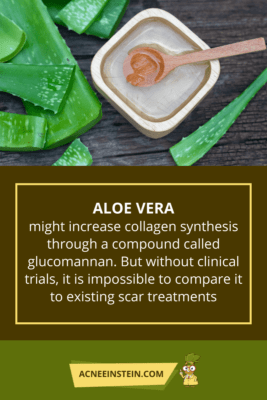
Coconut Oil
This is another controversial ingredient when it comes to scar treatment. Coconut oil may be an excellent moisturizer, but its effectiveness for scars is questionable.
Researchers have long believed that the answer lies in coconut oil’s high vitamin E content. However, studies on vitamin E for scars have so far proved inconclusive.
Once again, more studies are needed to determine if coconut oil really works on scars.
Conclusion
Half the battle of finding effective scar treatments is separating facts from fiction.
Now that you know what works and what doesn’t for acne scars, you can start to fade those daily reminders of your struggle with acne.
For more acne scar treatments and scar prevention tips, check out my full guide on how to get rid of acne scars.

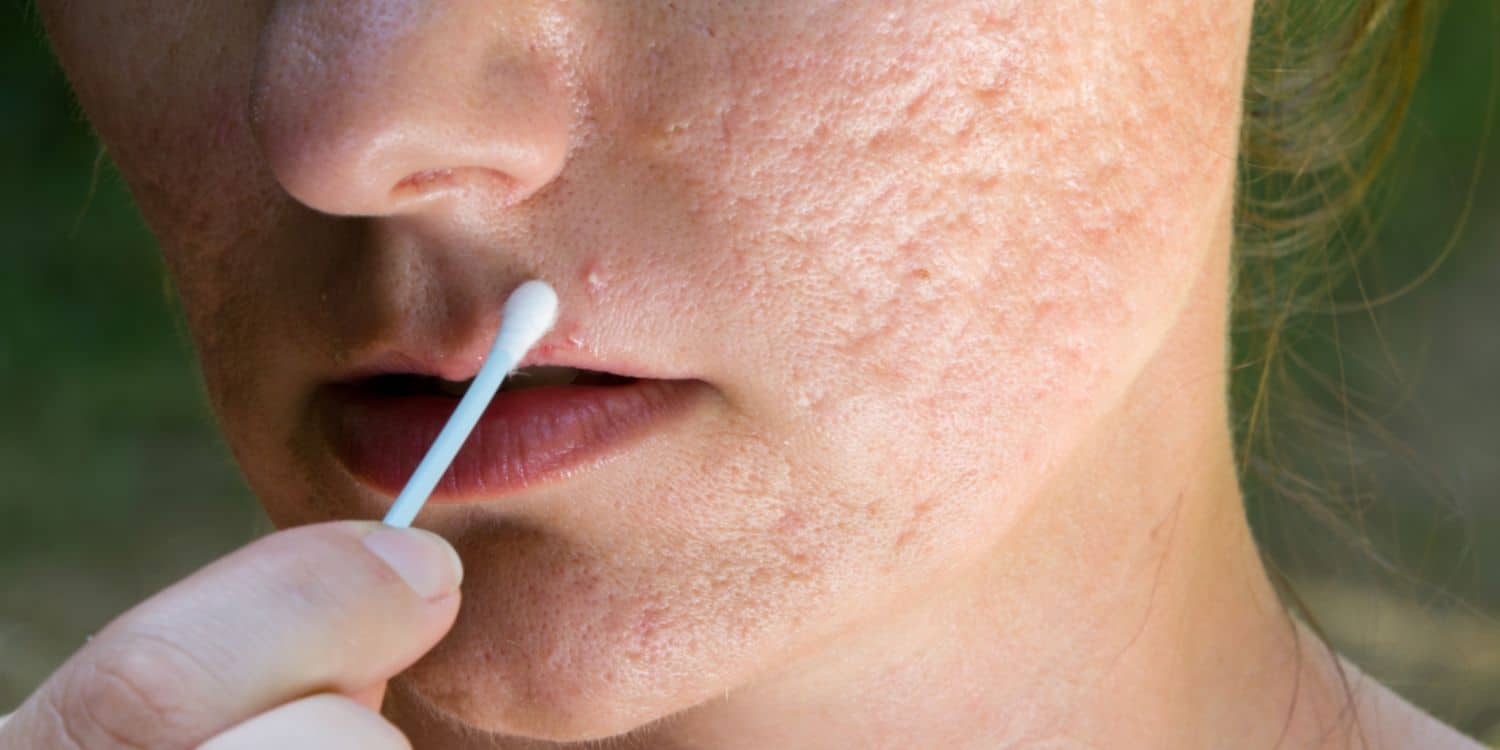
Hi , you never addressed the best way to help hyper pigmentation scars? Can you suggest what is best for these?
Hey Louise,
I would recommend vitamin C serums for hyperpigmentation scars. Look for L-ascorbic acid which is the pure form of vitamin C. Something in the range of 10-15% concentration works well, particularly for severe hyperpigmentation. You can read more about vitamin C serums here:
https://www.thedermdetective.com/best-vitamin-c-serum-for-hyperpigmentation/
Buy Retin A for severe kind of acne such as cystic and nodules. It is particularly effective in treating blackheads and whiteheads, therefore prevent the formation of pimples. Retin A is a brand name of topical tretinoin, which belongs to the class of the drugs known as retinoids. It is a powerful treatment when it comes to reducing the severity of cystic acne. One can buy Retin A online from alldaychemsit.com; here, you will get authentic medicated products. You can trust this website when it comes to buying original medications and health care products.
I used to have atrophic scars after acne. I tried microdermabrasion, microneedling and fractional laser. Among them, microdermabrasion has the worst effect. The effect of the microneedle is not bad, but it has to be done many times. The postoperative trauma of the fractional laser is large, but the effect is remarkable. About 70%-80% of atrophic scars can be eliminated after three or four times.